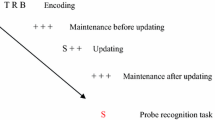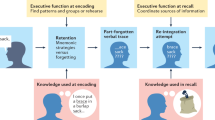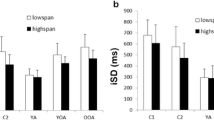Abstract
Many studied reported that working memory components receive remarkable changes during lifespan. In order to better investigate this, we evaluated working memory components on human subjects belonging to five groups (10 subjects each) at different ages 6, 8 and 10 years old, young adult (age) and old adult (age). Our pattern of results shows a major transition in object sequence manipulation performance between ages 8 and 10 years. If related to young adults results, both 10-year-old children and old adults differed in accuracy and RT (specificare cosa significa) in both maintenance and manipulation conditions. In particular, young adults and old adults differ in RTs in the manipulation condition. Our results also suggest that a change in response strategy from 6 to 8 years of age, to prioritize accuracy may be present. Our findings appear consistent with recent neuroscientific findings, and lead to novel predictions.

Similar content being viewed by others
References
Alloway TP, Gathercole SE, Willis C, Adams AM (2004) A structural analysis of working memory and related cognitive skills in early childhood. J Exp Child Psychol 87:85–106
Alloway TP, Gathercole SE, Pickering SJ (2006) Verbal and visuospatial short-term and working memory in children: are they separable? Child Dev 77:1698–1716
Baddeley AD (2000) Working memory: the interface between memory and cognition. In: Gazzaniga M (ed) Cognitive neuroscience: a reader. Blackwell Publishers Ltd, Oxford, pp 292–304
Baddeley AD, Hitch GJ (1974) Working memory. In: Bower GA 284 (ed) The psychology of learning and motivation. Academic Press, 285 New York, pp 47–89
Banich MT, Passarotti AM, Janes D (2000) Interhemispheric interaction during childhood: I Neurologically intact children. Dev Neuropsychol 18:33–51
Braver TS, Barch DM (2002) A theory of cognitive control, aging cognition, and neuromodulation. Neurosci Biobehav Rev 26:809–817
Braver TS, West R (2008) Working memory, executive control, and aging. In: Craik FIM, Salthouse TA (eds) The handbook of aging cognition. Psychology Press, New York, pp 311–372
Braver TS, Barch DM, Kelley WM, Buckner RL, Cohen NJ, Miezin FM, Snyder AZ, Ollinger JM, Akbudak E, Conturo TE, Petersen SE (2001) Direct comparison of prefrontal cortex regions engaged by working and long-term memory tasks. Neuroimage 14:48–59
Cansino S, Hernández-Ramos E, Estrada-Manilla C, Torres-Trejo F, Martínez-Galindo JG, Ayala-Hernández M, Gómez-Fernández T, Osorio D, Cedillo-Tinoco M, Garcés-Flores L, Beltrán-Palacios K, García-Lázaro HG, García-Gutiérrez F, Cadena-Arenas Y, Fernández-Apan L, Bärtschi A, Rodríguez-Ortiz MD (2013) The decline of verbal and visuospatial working memory across the adult life span. Age (Dordr) 35:2283–2302
Crone EA, Wendelken C, Donohue S, van Leijenhorst L, Bunge SA (2006) Neurocognitive development of the ability to manipulate information in working memory. Proc Natl Acad Sci USA 103:9315–9320
D’Esposito M, Postle BR (1999) The dependence of span and delayed-response performance on prefrontal cortex. Neuropsychologia 37:1303–1315
Gathercole SE (1999) Cognitive approaches to the development of short-term memory. Trends Cogn Sci 3:410–418
Giedd JN, Blumenthal J, Jeffries NO, Castellanos FX, Liu H et al (1999) Brain development during childhood and adolescence: a longitudinal MRI study. Nat Neurosci 2:861–863
Hitch GJ, Towse JN, Hutton U (2001) What limits children’s working memory span? Theoretical accounts and applications for scholastic development. J Exp Psychol Gen 130(184–198):10
Hutton UMZ, Towse JN (2001) Short-term memory and working memory as indices of children’s cognitive skills. Memory 9(4–6):383–394. doi:10.1080/09658210042000058
Liu HL, Liao WT, Fang SY, Chu TC, Tan LH (2004) Correlation between temporal response of fMRI and fast reaction time in a language task. Magn Reson Imaging 22:451–455
Olesen PJ, Westerberg H, Klingberg T (2004) Increased prefrontal and parietal activity after training of working memory. Nat Neurosci 7:75–79
Owen AM, Doyon J, Petrides M, Evans AC (1996) Planning and spatial working memory: a positron emission tomography study in humans. Eur J Neurosci 8:353–364
Pickering SJ (2001) The development of visuo-spatial working memory. Memory 9:423–432
Pickering SJ, Gathercole SE, Peaker SM (1998) Verbal and visuospatial short-term memory in children: evidence for common and distinct mechanisms. Mem Cogn 26:1117–1130
Rubia K, Smith AB, Brammer MJ, Taylor E (2003) Right inferior prefrontal cortex mediates response inhibition while mesial prefrontal cortex is responsible for error detection. Neuroimage 20:351–358
Schneider W, Kron V, Hünnerkopf M, Krajewski K (2004) The development of young children’s memory strategies: first findings from the Würzburg Longitudinal Memory Study. J Exp Child Psychol 88:193–209
Smith EE, Jonides J (1999) Storage and executive processes in the frontal lobes. Science 283:1657–1661
Smith AB, Taylor E, Brammer M, Rubia K (2004) Neural correlates of switching set as measured in fast, event-related functional magnetic resonance imaging. Hum Brain Mapp 21:247–256
Shing YLT, Lindenberger U, Diamond A, Li S-C, Davidson MC (2010) Memory maintenance and inhibitory control differentiate from early childhood to adolescence. Dev Neuropsychol 35:679–697
Sowell ER, Thompson PM, Leonard CM, Welcome SE, Kan E, Toga AW (2004) Longitudinal mapping of cortical thickness and brain growth in normal children. J Neurosci 24:8223–8231
Van Petten C, Plante E, Davidson PS, Kuo TY, Bajuscak L, Glisky EL (2004) Memory and executive function in older adults: relationships with temporal and prefrontal gray matter volumes and white matter hyperintensities. Neuropsychologia 42(10):1313–1335
Author information
Authors and Affiliations
Corresponding author
Rights and permissions
About this article
Cite this article
Federico, F., Delogu, F. & Raffone, A. Maintenance and manipulation of object sequences in working memory: a lifespan study. Neurol Sci 35, 1883–1887 (2014). https://doi.org/10.1007/s10072-014-1851-0
Received:
Accepted:
Published:
Issue Date:
DOI: https://doi.org/10.1007/s10072-014-1851-0




